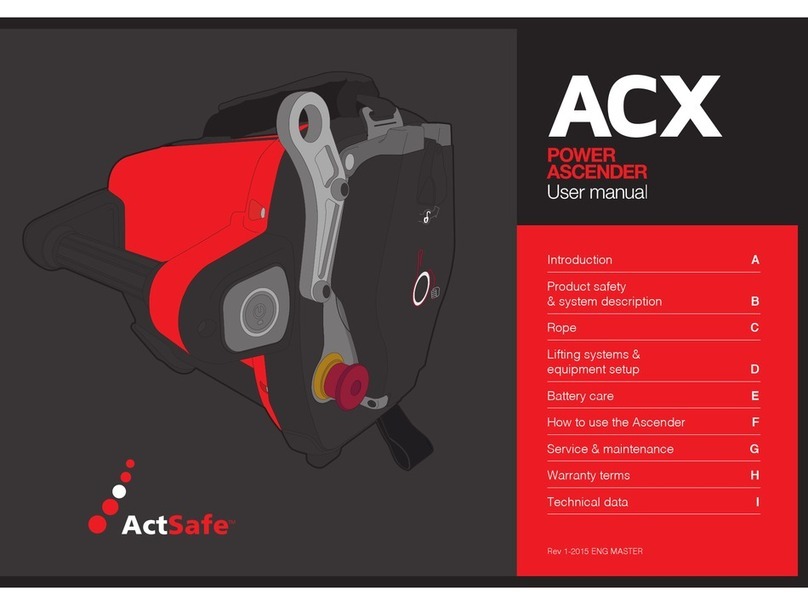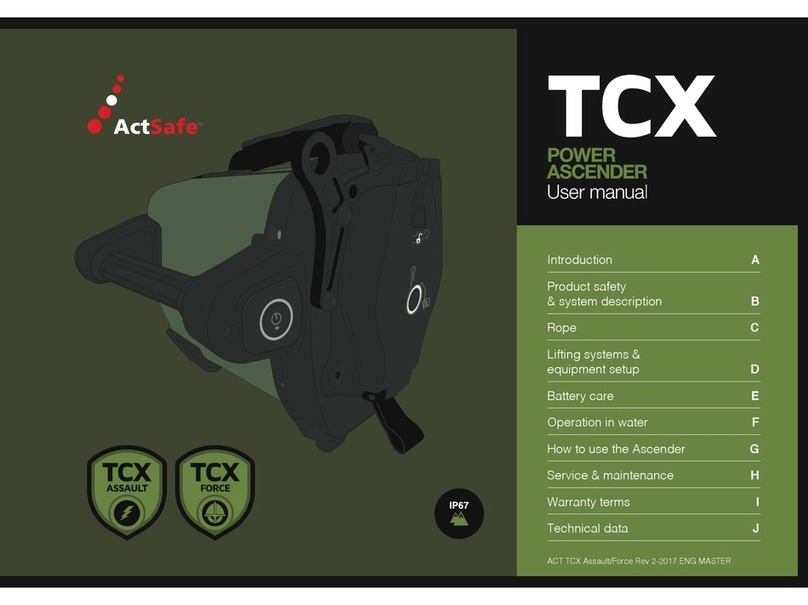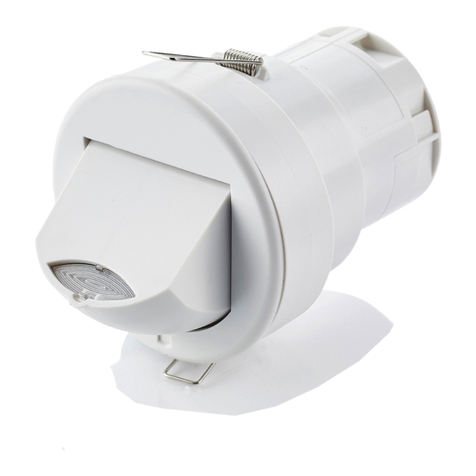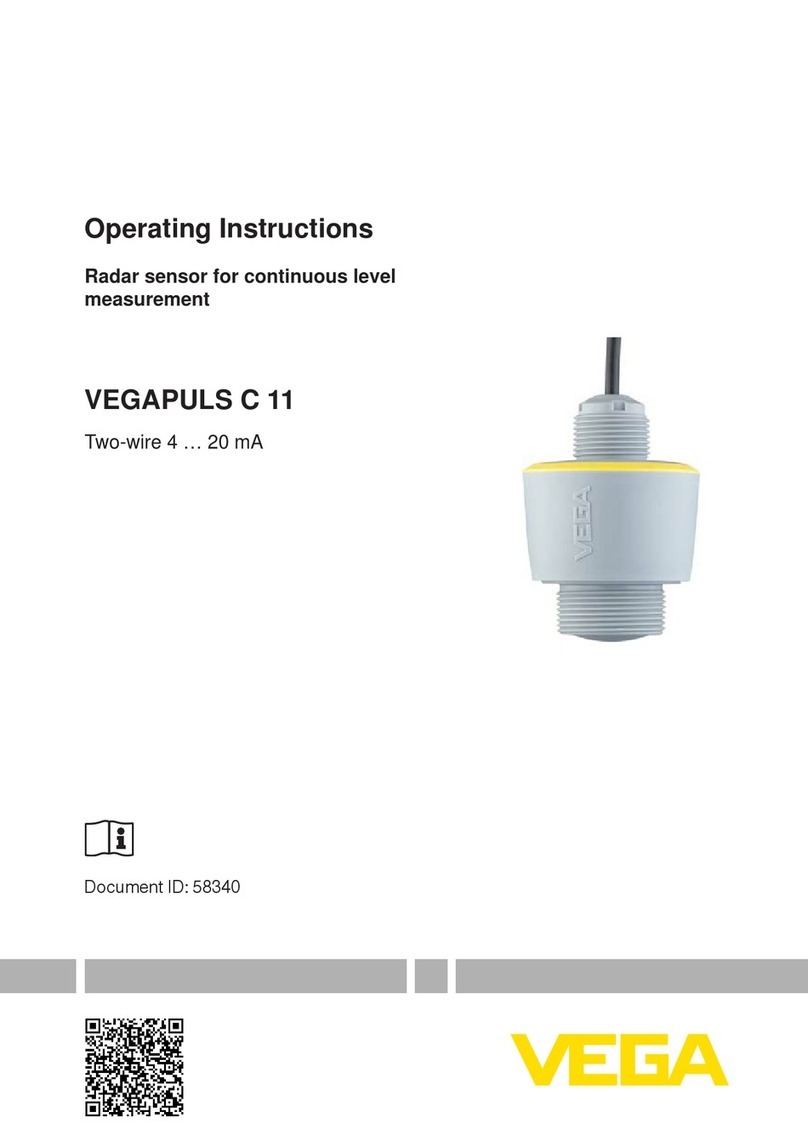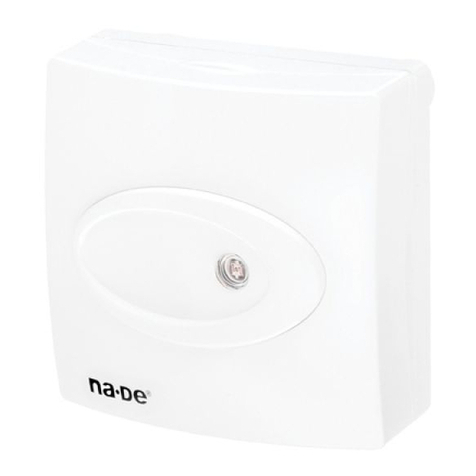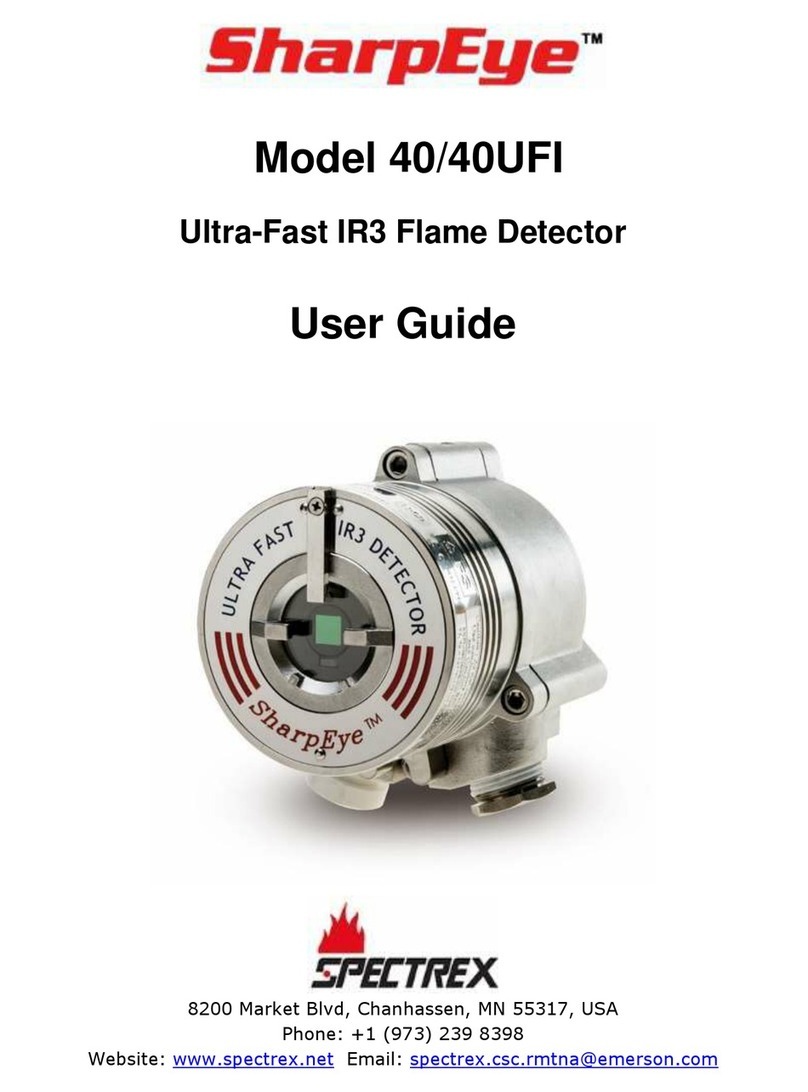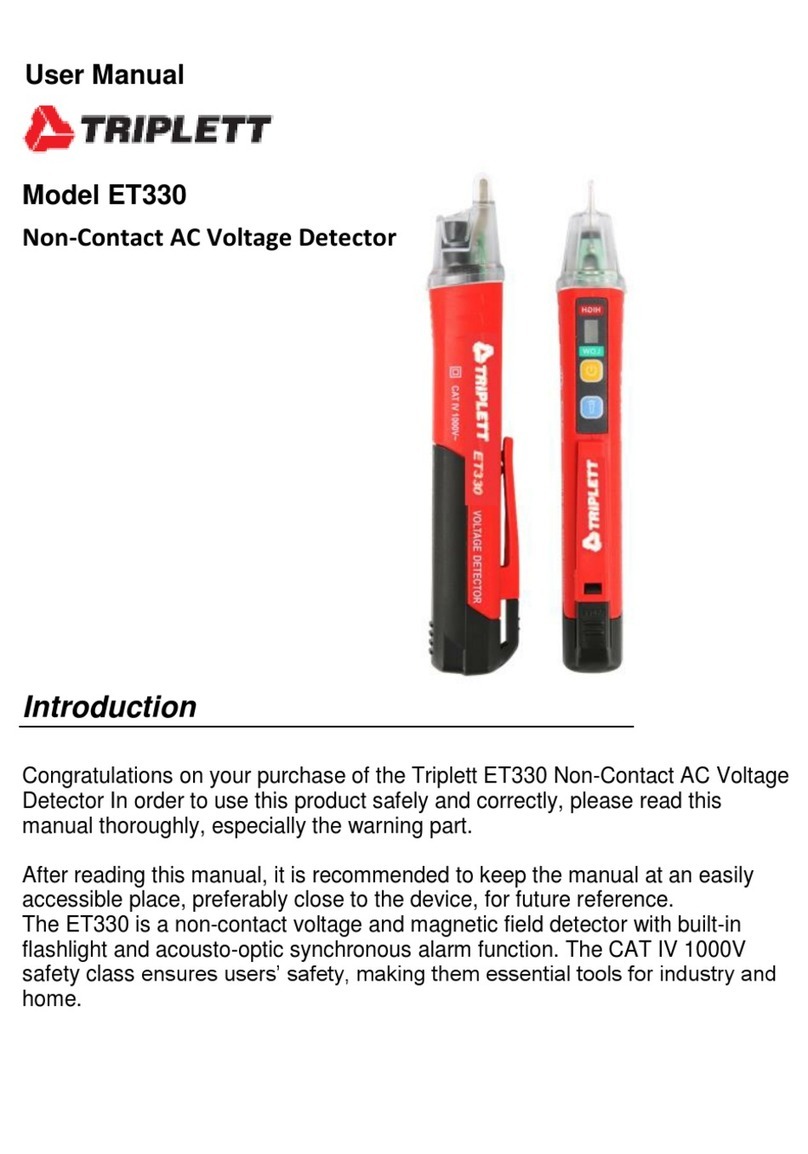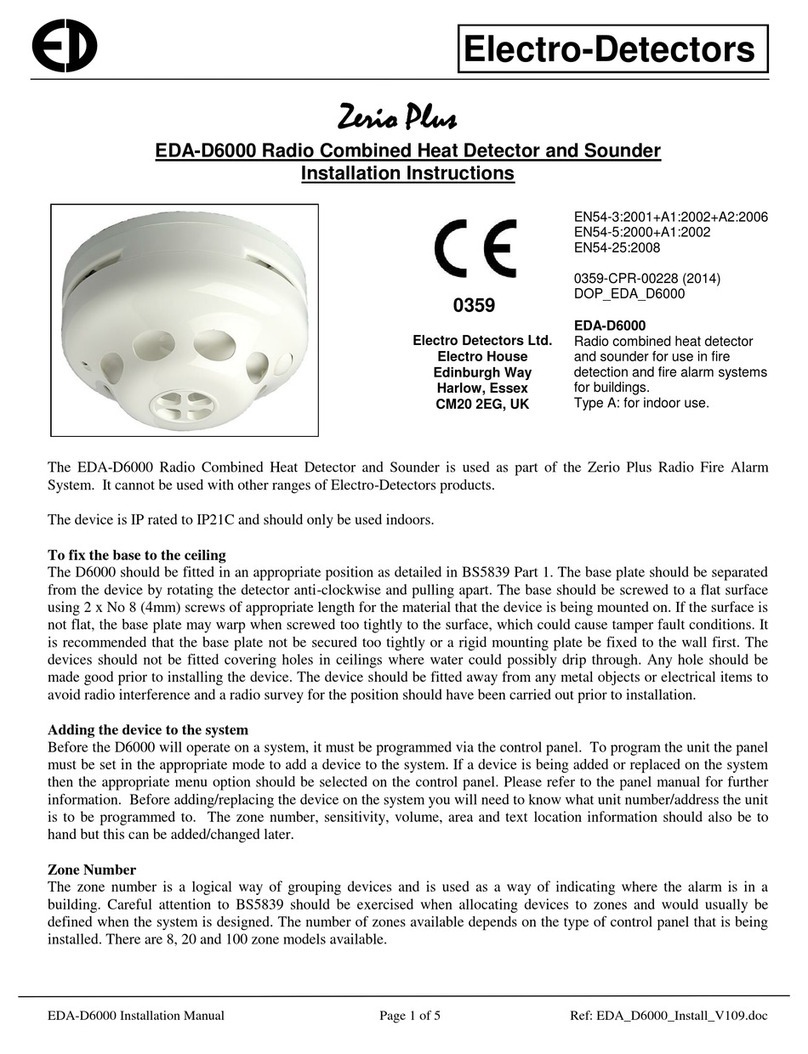ActSafe ACC II Ascender User manual

2
User’s Manual ACC II Ascender Rev 1-2013
ActSafe ACC II
Ascender
USER’S MANUAL
Rev 1-2014 ENG MASTER

2© Copyright ActSafe Systems AB
ACC II Ascender User’s Manual revision 1-2013
©Copyright 2013 ActSafe Systems AB
www.actsafe.se | info@actsafe.se
DISCLAIMER
This manual is not intended, in any way,
to teach an individual how to use a power
ascender. It is only to be used as a reference
source in conjunction with a“controlled
program of instruction”in the use of this
power ascender system, conducted by a
qualied ActSafe Instructor.
An ActSafe Power Ascender is not a safety
device. It is specically designed as a tool
to assist in the ascending and descending
of personnel and tools or materials and is
always to be used in conjunction with a
fully independent working Backup system.
Act Safe Systems AB makes no guarantee
that the ActSafe Power Ascender will increase
the user’s personal safety or free the user
from possible serious injury or death or
that the ActSafe Power Ascender operates
as a lifesaving mechanism.
Act Safe Systems AB, our partners and
subsidiaries disclaim any liability or respon-
sibility for damages, injuries or death resul-
ting from the use or misuse of an ActSafe
Power Ascender.
The ActSafe Power Ascender should
not be operated by persons who do not
possess evidence of approved training in
the use of the ActSafe Power Ascender, it is
recommended that operators should have
a rope access qualication. However, even
with this requirement, Act Safe Systems AB
has no control over the use of this equip-
ment and the person using this equipment
assumes all risk of damage, injuries or death
resulting from such use. It is expressly
understood and agreed by the buyer or
any subsequent user of the ActSafe Power
Ascender that Act Safe Systems AB and/
or the seller in no way be deemed or held
liable or accountable for any liability or
responsibility for damages, injuries or
death resulting from the use of the ActSafe
Power Ascender, and makes no warranty,
either expressed or implied, statutory, by
operation of law or otherwise, beyond that
expressed herein.
Act Safe Systems AB disclaims any liability
in tort for damages or direct or consequential
personal injuries or death resulting from
a malfunction or from a defect in design,
manufacturing, materials or workmanship,
whether caused by negligence on the part
of Act Safe Systems AB or otherwise.
By using the ActSafe Power Ascender, or
allowing it to be used by others, the buyer
and/or user waives any liability on the part
of Act Safe Systems AB for personal injuries,
death or other damages arising from such
use.
Actsafe expressly disclaims liability for errors
or omissions in this information and materials.
This information may be subject to change
without notication.
Training and experience are required to lower
the risk of serious bodily injury or death.
NEVER use this equipment unless you have read
the user’s manual and completed a “controlled
program of instruction” in the use of this power
ascender system. However, even with this require-
ment, Act Safe Systems AB has no control over the
use of this equipment and the person using this
equipment assumes all risk of damage, injuries
or death resulting from such use.
WARNING

3
User’s Manual ACC II Ascender Rev 1-2013
Disclaimer 2
INTRODUCTION 4
Foreword 4
About ActSafe 4
About this manual 4
Denitions 5
SAFETY 6
Ascender safety 6
General safety measures 6
Rope system safety 7
Alternative setup of bac-up system 8
Rope recommendations 10
Personal safety 11
Training 12
SYSTEM DESCRIPTION 13
General 14
Control panel 14
Battery & charging 15
Important information 15
General guidelines and warnings 15
Storage and transportation 16
Battery disposal 16
Connecting battery to ascender 17
Use in high temperatures 18
Use in low temperatures 18
Battery indicator 18
Charging 19
USAGE 20
Checklist before and after use 20
Transportation 21
Storage 21
Connect to rope 22
Ascent & descent 23
Emergency descent 24
Emergency stop 24
Twisted ropes, rotation 25
Remote control 26
SERVICE & MAINTENANCE 28
Clean the ascender 28
Clean the battery connecting pins 28
Changing the primary connection sling 28
Remote control, changing the batteries 29
Spare parts 29
Material 29
TROUBLE SHOOTING GUIDE 30
WARRANTY & GUARANTEE 33
TECHNICAL DATA 34
APPENDIX 35
Table of contents

4© Copyright ActSafe Systems AB
INTRODUCTION
INTRODUCTION
Foreword
Thank you for choosing a product from
Act Safe Systems.
When used correctly this ascender will
revolutionize the way you work at height.
This hoisting equipment makes it much
more convenient for you to reach your
workplace in combination with lifting
materials and tools.
About ActSafe
ActSafe introduced the worlds rst commer-
cially available Power Ascender back in
1997. Today we are the world leader within
this growing segment. Our innovative Power
Ascender are used all over the world in
industrial, rescue and military operations.
With almost two decades experience,
and a worldwide distribution, we develop
unique Power Ascender solutions in close
collaboration with our customers. We are
totally committed to our customers and do
our outmost to deliver top quality products
and service.
Thank you for choosing an ActSafe
Power Ascender.
Visit our website for more information
on ActSafe Power Ascenders. You will nd
important information and latest versions
of manuals. www.actsafe.se
About this manual
The information in this manual cannot
replace training and exercise. The ascender
must only be used by personnel who have
undergone proper training. Misuse may
result in serious injury or death.
Description of the manual
Safety messages of extra importance are
presented with the words danger and cau-
tion. The meanings of the signal words are:
Further information about consequences
and other details is presented like this.
NOTE!
The word “Note”will precede important
information about the equipment used
together with the ascender.
Not following these instructions may result
in SERIOUS INJURY or DEATH.
DANGER
User recommendation is described like this.
RECOMMENDATION
Not following these instructions may result
in INJURY or damage to property.
CAUTION
INTRODUCTIONINTRODUCTION

5
User’s Manual ACC II Ascender Rev 1-2013
INTRODUCTION
Denitions
WORD DESCRIPTION
Anchor Attachment point for rope or ascender.
Ascending Moving up on the rope.
Descending Moving down on the rope.
Primary rope Main rope used with ascender. Approved according to 1891 A.
Backup rope
/ Secondary rope
Safety rope that takes load if failure with primary rope.
Approved according to 1891 A.
Backup Device that stops a fall and limits the load.
Approved according to EN12841-A.
Active / Live rope Rope that is loaded during work.
Passive / Dead rope Unloaded rope during work.
User / Operator Operator of the ascender, either by speed control handle
or by remote control. There can be two or more at the same time.
Competent person Personnel with adequate training and certication for the assignment.
Factor 1 fall A fall of distance x m with x m of rope catching the fall.
Fall factor is fallen distance divided by length of rope catching it.
Descender Device for descending a rope. Approved according EN 12841 C.

6© Copyright ActSafe Systems AB
SAFETY
Ascender safety
Users of this product must have been certi-
ed or have undergone proper approved
training either by ActSafe Systems or by
ActSafe approved distributors.
The ascender must not be used:
•For anything other than that for
which it has been designed.
•In an explosive environment.
•If modied in any way by anyone
other than ActSafe Systems.
•After a free fall from a height more
than 1 meter against any hard surface.
•If subjected to a dynamic load as it is
designed to work in static systems only.
•If subjected to mis-use in any way
those parts or components may
have been damaged.
•In combination with other than
ActSafe original battery charger.
•In combination with damaged
or modied battery charger.
Use only original spare parts / material
recommended by ActSafe Systems.
Other battery chargers may damage the
battery and may cause development of toxic
gases or in worst-case scenarios cause an
explosion.
If unclear of the condition of the ascen-
der, it must be inspected and approved by
ActSafe Systems or an ActSafe approved
distributor before use.
The ActSafe Ascender and its equipment
must be checked before and after every use
and must be subject to at least one inspec-
tion per year (national regulations may
require more frequent inspections).
SAFETY
Read this chapter carefully and make sure
you understand its contents.
DANGER
General safety measures
•Plan and evaluate your work carefully,
a rescue plan should be in place.
If possible rig for rescue.
•Pre-use check.
•Due to the nature of workingwith
ActSafe winches operatives are hanging
for prolonged periods in a harness; we
recommend the use of a work seat when
hanging for prolonged periods.
• The area of risk under someone working at
height is within a radius of 2/3 of the height
and larger due to strong wind. Other persons
must keep away from the area of risk.
• Always secure tools and equipment.
RECOMMENDATION

7
User’s Manual ACC II Ascender Rev 1-2013
SAFETY
Rope system safety
The rope system must consist of a primary
rope (1) and a secondary back-up rope (2),
both must be approved according to 1891
A and have a diameter of 10-13mm.
The two ropes must have separate
anchor points that must hold at least 12 kN
each. A competent person shall judge if the
separate anchor points are sucient.
National regulations may require more.
The ACC ascends or descends on the
primary rope. If any part of the load car-
rying system should break then the load is
immediately transferred to the secondary
rope which, together with the fall arrester
(3) according to EN12841-A, provides a
backup system.
Do not descend on a twisted rope. It may
result in a rope jam or in the worst-case
scenario the rope being forced o the rope
grab.
Rope characteristics are an important
issue when using the ascender. Ropes with
characteristics not suitable for the ascender
might, in the worst-case scenario, result in
a jam between the rope grab and the knife,
with a damaged rope as a consequence.
3
1
2
Do not use the Ascender without a backup
system.
The lifting capacity of the ascender is higher
than the Safe Working Load (SWL) of the most
common backup devices. Therefore, when
lifting a load it may be necessary with separate
backup system(s) for the load. See the user’s
manual of the fall arrest device to nd out the
SWL.
DANGER
The dead rope must be unloaded. Do not
build cableways using the primary rope as
shown in the picture.

8© Copyright ActSafe Systems AB
SAFETY
Alternative setup of backup system
Next to the traditional setup of a separate
work and backup system the ActSafe ACC
ascender oers the possibility to make a
combined setup of both systems while
being connected to both work and fall
arrest point on your harness.
This setup gives advantages in both
safety and handling while using the
ascender. The backup device is connected,
ideally via a twisted shackle, to the secon-
dary connection point of the ascender the
backup system stays then always in way of
shoulder height of the operative.
The advantages are:
•The winch is caught by the backup in
case of a rope failure and will not hurt
the operator.
•The high position of the backup device
prevents slack in the backup system;
this will prevent high shock loads on
the system in case of a rope failure.
•The operative does not have to take
care of his backup system it is kept in
the right position by the ascender.
NOTE!
Do not put the backup system directly
into the secondary connection point. It
will become very dicult, In case of a line
failure, to put the backup rope into to
ascender safely for emergency descent/
ascent.
•Be aware that, in case of a rope failure,
the operative is caught by the winch and
not by his energy absorber. The impact
force on both ascender and operator are
very low because the backup is a very
high position and next to that does the
rope above the winch dampen the impact.
We recommend that there is always a
minimum of 1 meter of rope above the
ascender when using this setup.
Recommended equipment
Shackle:
Wichard stainless steel twisted captive pin
shackle, 8 ømm, 3700 Kg breaking load.
Product reference: 1424
Fixation rubber:
Contact ActSafe dealer

9
User’s Manual ACC II Ascender Rev 1-2013
SAFETY
3) Connect the ascender to the low
attachment point (EN 813) of the
harness and connect the energy
absorber of the backup to the fall
arrest point (EN 361) and you are
ready to go.
1) Connect the twisted shackle with
the rubber xation, as shown, to the
secondary connection point of the
ascender.
2) Put rst the backup carabiner
trough the shackle before connec-
ting this to the backup.

10 © Copyright ActSafe Systems AB
SAFETY
The user should carry out tests with the rope
normally used prior to operations involving the
ascender. Consult ActSafe for more information
and assistance in the test of the rope.
A new rope will get an increased service life if it
is put to soak in cold water before the rst use.
Avoid getting sand or dirt onto/into the ropes
since it will wear the rope grab and loop. Use a
rope mat, rope bag or similar.
RECOMMENDATION
Always make sure that the rope is in good
condition.
DANGER
Rope recommendations
ActSafe ACC is designed for 1891 A ropes.
However, all 1891 A ropes does not perform
well with the ascender. ActSafe has tested a
variety of ropes; please see our website for
more information.
Please read and understand the tips and
directions regarding ropes below and you
will get more out of your ropes as well as
your ActSafe Ascender.
As a rule of the thumb one can say that
extremely soft ropes don’t get good grip in
the rope grab. A very soft rope may result
in poor lifting capacity since the rope starts
to slip or in the worst-case scenario even a
jam.
Before using for the rst time, new ropes
must be soaked in cold water (20-30 C) for
at least 24 hours or according to the rope
manufacturers’instructions, and allowed to
dry thoroughly at room temperature before
using with the power ascender.
NOTE! Not all 1891 A ropes perform in a simi-
lar way. They have slightly dierent characte-
ristics (sti, soft, thick/thin mantle etc).

11
User’s Manual ACC II Ascender Rev 1-2013
SAFETY
3
4
5
1
2
Personal safety
Before use make
sure that you
•Check all components
in the system.
•Use appropriate PPE
(Personal Protective
Equipment, for ex-
ample helmet, gloves
and
protective eye wear, 5).
•Use appropriate
clothes without
loose hanging parts.
•If necessary bind
long hair and beards
to keep the shoulder
region free.
When using make
sure that you
•Pay attention and use
common sense.
•Do not hold the rope
just above the winch;
there is a risk of being
pinched.
•Keep your hands and
feet o rotating parts.
•Avoid pendulum
movement when
starting to ascend.
The user must wear a combination harness (1,2) approved
according to EN813: 2008 (low attachment point for the
primary rope, 3) as well as EN361 (high attachment point for
the secondary rope or fall arrester, 4).
Do not use the ascender if you are tired, ill or under the
inuence of alcohol, drugs or medication.

12 © Copyright ActSafe Systems AB
SAFETY
Working at height or in locations presen-
ting dicult or conned access requires
great skill and such standards can only be
achieved as a result of extensive training
and regular refresher courses.
ActSafe oers winch specic user train-
ing for dierent competence levels as
show below. Please consult with your local
ActSafe distributor for further information.
Training
Users of this product must have undergone
proper approved training either by ActSafe
Systems or by ActSafe approved distributors.
The ActSafe ACC ascender makes it pos-
sible to access heights and depths in a very
quick, safe and reliable way.
The ascenders are very easy to implement
within various work methods and is invalu-
able in places where access is dicult or
impossible by other means. Because of the
variety of use in dierent areas and circum-
stances training is essential.
ACTSAFE BASIC+ WINCH TRAINING
Duration: 1 Day
Experience: Trainees should have as minimum requirement a
good level of competence and training in work at height
This training is designed for operatives who need good basic
understanding for a specic on the job application of the winch.
ACTSAFE ADVANCED
WINCH ACCESS TRAINING
Duration: 2 day training
Experience: Trainee should have
a rope access level.
This training is designed for rope access
operatives to give them a thorough under-
standing how to use the winch in an rope
access environment; general and job
specic. Winch access!
ACTSAFE ADVANCED
WINCH RESCUE TRAINING
Duration: 2 day training
Experience: Trainee should have
a rope rescue background.
This training is designed for rope rescue
professionals to learn about rescue capa-
bilities of the winch. This training provides
general and job specic knowledge.
Winch Rescue!
ACTSAFE EXPERT TRAIN THE TRAINER TRAINING
Duration: 2 day training
Experience: Trainee should have attended a ActSafe Advanced Winch Access Training or
have a solid Rope Access/Rescue background (Preferably IRATA L3 or similar).
This training is intended for Rope Rescue / Access professionals to gain an in-depth
knowledge of the ActSafe Winches so they can afterwards perform ActSafe Training.

13
User’s Manual ACC II Ascender Rev 1-2013
SYSTEM DESCRIPTION
SYSTEM DESCRIPTION
NO PART
1 Rope grab system
2 Lifting handle
3 Control Panel
4 Pocket for Emergency Descender handle
5 Speed control handle
6 Emergency stop
7 Primary connection (8+9)
NO PART
8 Sling
9 Attachment karabiner
10 Chassis
11 Secondary Connection point
12 Battery Connector (hidden)
13 Battery pouch
1
2
6
3
7
4
9
5
10
8
13
11
12

14 © Copyright ActSafe Systems AB
SYSTEM DESCRIPTION
1
2
3
4
NO PART
1 Rope guide
2 Knife
3 Rope cover
4 Rope grab
NO PART
1 Battery indicator
2 Power button
3 Ascend button
4 Descend button
General
This ascender has been designed for lifting/
lowering a person or load in a static rope
system (including backup rope), with ropes
of 10-13mm approved by EN1891. The dead
rope shall be unloaded.
The karabiner in the primary connection
can be replaced by any other karabiner
approved by EN362. The sling in the chassis
cannot be replaced, by anything other than
an original spare part from ActSafe Systems.
Control panel
All buttons are equipped with LEDs that
indicate the travel mode that is active.
1 2 3 4

15
User’s Manual ACC II Ascender Rev 1-2013
SYSTEM DESCRIPTION
Battery & charging
Important battery safety
and handling information!
ActSafe Power Ascender batteries are
extremely powerful but at the same time
compact and lightweight. The batteries use
high performance lithium-based battery
technology that delivers very high power
and energy density. Charged and used cor-
rectly your ActSafe Power Ascender battery
will give you a high level of performance
throughout its service life.
However, lithium-based battery techno-
logy is still in development. To minimize the
associated risks our batteries have a custom
designed Battery Management System (BMS).
This BMS reduces risks considerably, but
cannot totally eliminate all risks. The BMS
itself could break down or a battery cell
might have an internal weakness not detec-
table during the manufacturing process.
It is not possible to design a totally failsafe
BMS.
Please read and understand these safety
instructions and warnings before using
or charging your ActSafe Power Ascender
battery. By purchasing an ActSafe battery,
the buyer assumes all responsibility for all
risks associated with lithium-based battery
technology. Product warranty is limited to
original defects in material and workman-
ship. Warranty does not cover collateral
damage.
Failure to read and follow the instructions
below may result in re, personal injury and
damage to property if the battery is charged
/ used improperly.
General guidelines and warnings
•Disconnect the battery from
the ascender when not in use.
•Always charge the battery as soon
as possible after use.
•Disconnect the battery from the
charger after charging.
•The battery may explode resulting in re
if misused or if the battery is defective.
All users of the ActSafe Power Ascenders
and associated batteries must be profes-
sionals who can handle an emergency
situation.
•A severe failure during charging of the
battery may result in re or explosion.
Unattended charging must be conducted
in a safe and isolated area away from
combustible or other ammable mate-
rials and where any potential damage is
minimized.
•An old or spent battery, or a battery sho-
wing poor performance, must be taken
out of service and replaced with a new
one. A Power Ascender is a demanding
battery application. This contributes to a
relatively short service life for the battery.
- Replace the battery in accordance
with the expiry date label1.
- Replace the battery when less than
80 % of the initial capacity remains.
•Immediately remove the battery
from service:
- If there is visible damage to the hou-
sing, cables or the connector, including
the battery connector on the power
ascender.
- If the battery has been dropped.
The battery may have received internal
damage that cannot be detected from
the exterior.

16 © Copyright ActSafe Systems AB
SYSTEM DESCRIPTION
1) Batteries produced after June 2013 are marked with an expiry date label. Batteries purchased
before this date, without an expiry date label, should be taken out of service after 24 months at
the latest from the date of purchase from the ActSafe distributor.
•Allow the battery to cool down to
ambient temperature before charging.
•Only use the original ActSafe battery
charger.
•Do not short circuit the battery. This can
cause re. If a short circuit occurs and
contact is made with metal (for example
with rings on your hand), severe injuries
may occur due to the conductibility of
electric current.
•Do not disassemble or modify the bat-
tery. The battery contains safety and
protection devices, which, if damaged,
may cause the battery to generate heat,
explode or ignite.
•Immediately discontinue use of the battery
if, while using, charging or storing the
battery, the battery emits an unusual
smell, feels hot, changes shape, or appears
abnormal in any other way. Since a
delayed chemical reaction can occur, it
is best to observe the battery for at least
15 minutes as a safety precaution. Obser-
vation should occur in a safe area outside
of any building or vehicle and away from
any combustible material.
•Do not expose the battery to water
or salt water, or allow the battery to
get wet.
•Do not overcharge the battery. Over-
charging may occur during descending
with a fully charged battery. Descending
should be done with a partially charged
battery.
Storage and transportation
•All lithium-ion batteries degenerate over
time, they age, even if they are properly
stored.
•Store the battery with 100 % charge.
•Storing an empty battery or a battery
with low charge level will drain the
battery and damage it irreversibly.
•Recharge the battery every third month
if stored for an extended period of time.
•Store the battery at room temperature
5 to 25 degrees C (40 to 80 degrees F).
Storing at higher temperatures will result
in a loss of performance and a shortened
life expectancy.
•Storing the battery at a higher tempe-
rature can cause irreversible damage.
Storing the battery at temperatures
higher than 60 degrees C (140 degrees F)
for extended periods of time may cause
damage to the battery and possible re.
•The battery is a fully regulated as Dange-
rous Goods (Class 9 UN3480 Lithium Ion
Batteries) and must be handled and ship-
ped accordingly.
•A defective battery must not be shipped.
Battery Disposal
•Do not incinerate or dispose the battery.
Return end-of-life battery to your nearest
recycling center as per the appropriate
regulations.

17
User’s Manual ACC II Ascender Rev 1-2013
SYSTEM DESCRIPTION
112
Connecting the battery to the ascender
ActSafe recommends having at least one extra
battery when working in order to avoid unde-
sired breaks as a result of a at battery.
RECOMMENDATION
When used in cold environments maintain the
battery temperature by keeping the battery in
the transportation box as long as possible. This
will prolong the time before performance is
limited.
When using the ascender with a cold battery,
be aware that the initial lift speed capacity
will be limited. It is only possible to ascend at
lower speeds before the battery warms up and
normal performance can be expected.
RECOMMENDATION
1. Align the slit of the battery connector
with the tap of the male connector
placed inside the bag of the ascender.
2. Rotate the ring of the connector all the
way to the stop position in order to lock
the connector in place. There might be
a small spark when connecting the
battery, this is normal.

18 © Copyright ActSafe Systems AB
SYSTEM DESCRIPTION
Use in low temperatures
The capacity of the battery depends on the
battery temperature. Extreme temperatures
will aect the capacity, most noticeably in
cold temperatures.
When the battery is cold it can behave as if
the charge level is low. This may cause the
battery indicator to show the wrong level.
The indicator will return to normal after
next recharge.
Use in high temperatures
The capacity is less aected by high
battery temperature. The lifted height will
be slightly decreased. The ascender is well
designed to do its work in the full tempera-
ture range. The risk of over heating is very
small.
Battery indicator
The battery indicator has 4 LEDs each
representing 25% charge.
When connecting a fully charged battery
to the ACC all LEDs of the indicator will be
activated, i.e. indicating a full battery.
The battery indicator only functions
correctly if a fully charged battery is
connected. If a battery with less than full
charge is connected the indicator will show
the last known value, i.e. the indicator will
show an incorrect value.
LEDs BATTERY CAPACITY
1 red 3 green 75-100%
1 red 2 green 50-75%
1 red 1 green 25-50%
1 red 0-25%

19
User’s Manual ACC II Ascender Rev 1-2013
SYSTEM DESCRIPTION
If the main supply is interrrupted several
times during the second cycle (and the 4 hrs
timer reset) there is a risk of over charging,
i.e. a risk of damaging the battery.
DANGER
Charging
The battery can be charged whether its
only used a little or if almost empty, no
so called ”memory eect” will occur.
The charger is not capable of measuring the
charging level; hence it cannot determine
when the battery is fully charged. For this
reason the charger is timer controlled.
The charging process consists of the cycle
described below:
1. Connect the charger to main supply.
2. Connect the battery to the charger.
3. Constant current charging (fast charging).
During this cycle the LED on the charger
is red. This phase takes approximately
1 hour and 15 minutes. After this cycle
is nished the battery is charged to 80%.
4. Constant voltage charging (slow char-
ging). During this phase the led on the
charger is yellow. After approximately
3 hours and 30 minutes after the charging
started the battery has 100% charge,
however the charging cycle continues as
the cells in the battery sometimes need
to be balanced.
5. After 5 hours and 15 minutes the
charging cycle is complete and the led
on the charger is green. Float charging
mode will start automatically.
6. Disconnect the battery from the charger
as it will slowly be drained if it remains
connected to the charger.
7. Disconnect the charger from main supply.
Failure to disconnect the charger from the
battery when the charger is disconnected
from the mains supply will slowly drain the
battery to a level where charging is no more
possible.
CAUTION
The total charging cycle is all together around
5 hrs. The battery is however fully charged
already after 3,5 hrs. The battery may therefore
be disconnected after 3,5 hrs, there is no need
to wait until the LED shows GREEN.
RECOMMENDATION
Use the transportation box to extend
the service life of the ascender.
FAST
CHARGING
CHARGER
LED COLOR
1:15 hrs
80%
0Time lapse:
Charged:
3:30 hrs
100%
5:15 hrs
100%
SLOW
CHARGING BALANCING
Ready to use
FLOAT
CHARGING
1
2
3 4 56
7

20 © Copyright ActSafe Systems AB
USAGE
USAGE
The user must make sure that the ascender
is in full working order and the pre-use
check have been made before each use
of the ascender. If in doubt do not use the
ascender and consult ActSafe or an appro-
ved distributor.
Check the ascender and its components
for loose parts, excessive wear and dama-
ges. Damage includes cracks, marks and/or
abnormal wear indicating the product has
been subject to excessive force or impact
energy.
Checklist before and after use
If the rope guide is less than 7mm thick, it shall
be replaced.
DANGER
Inspect the rope grab system in particular;
•The rope grab, for example the ridges,
should be intact.
•The rope cover.
•The rope guide.
•The knife.
Further inspect
•The primary connection; the sling
and the karabiner.
•The chassis, especially the area for
the primary connection.
•That the ascender functions
and controls are fully functional.
•The battery charge level is sucient
for the assignment.
•Annual inspection performed
according to ActSafe’s recommendations
as well as national regulations.
•The battery charge level is enough
for the assignment.
•All other parts.
If in doubt about the condition of the
ascender consult either ActSafe Systems
or an approved distributor.
Table of contents
Other ActSafe Security Sensor manuals
Popular Security Sensor manuals by other brands
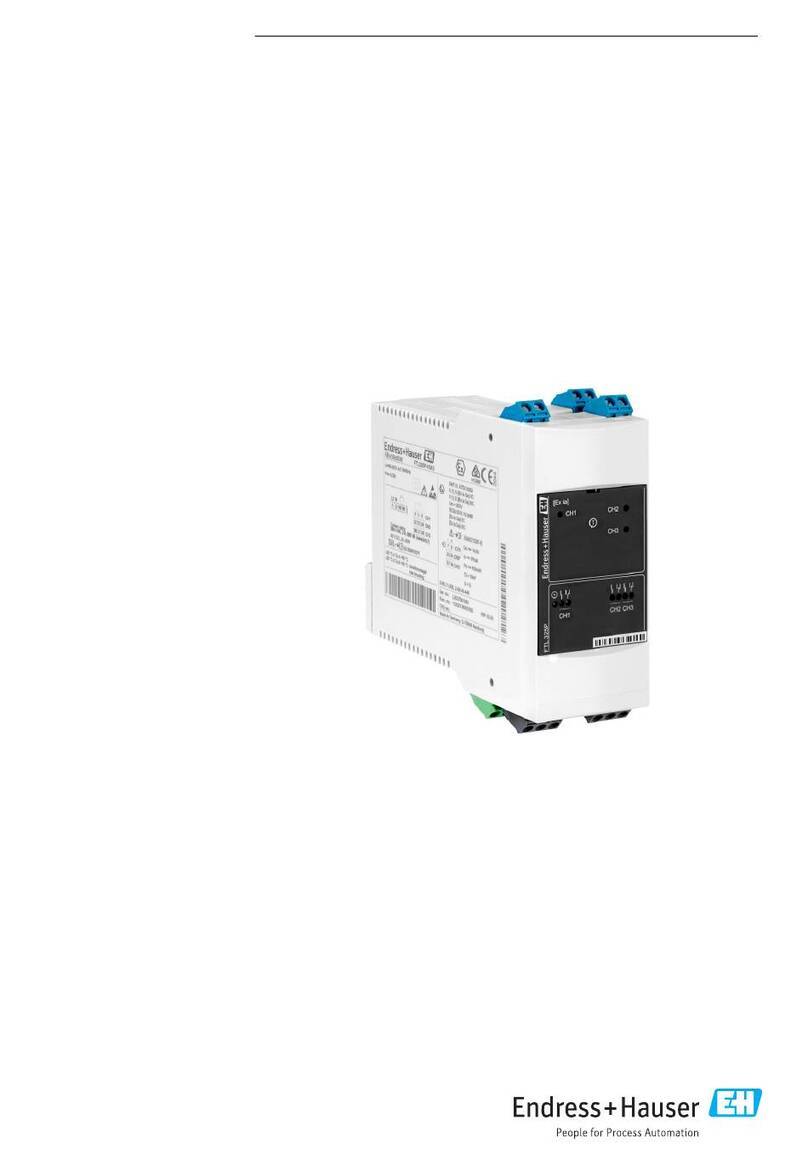
Endress+Hauser
Endress+Hauser Nivotester FTL325P-H3A3 Brief operating instructions

Capital Safety
Capital Safety DBI SALA PROTECTA EN361 Instructions for use and maintenance
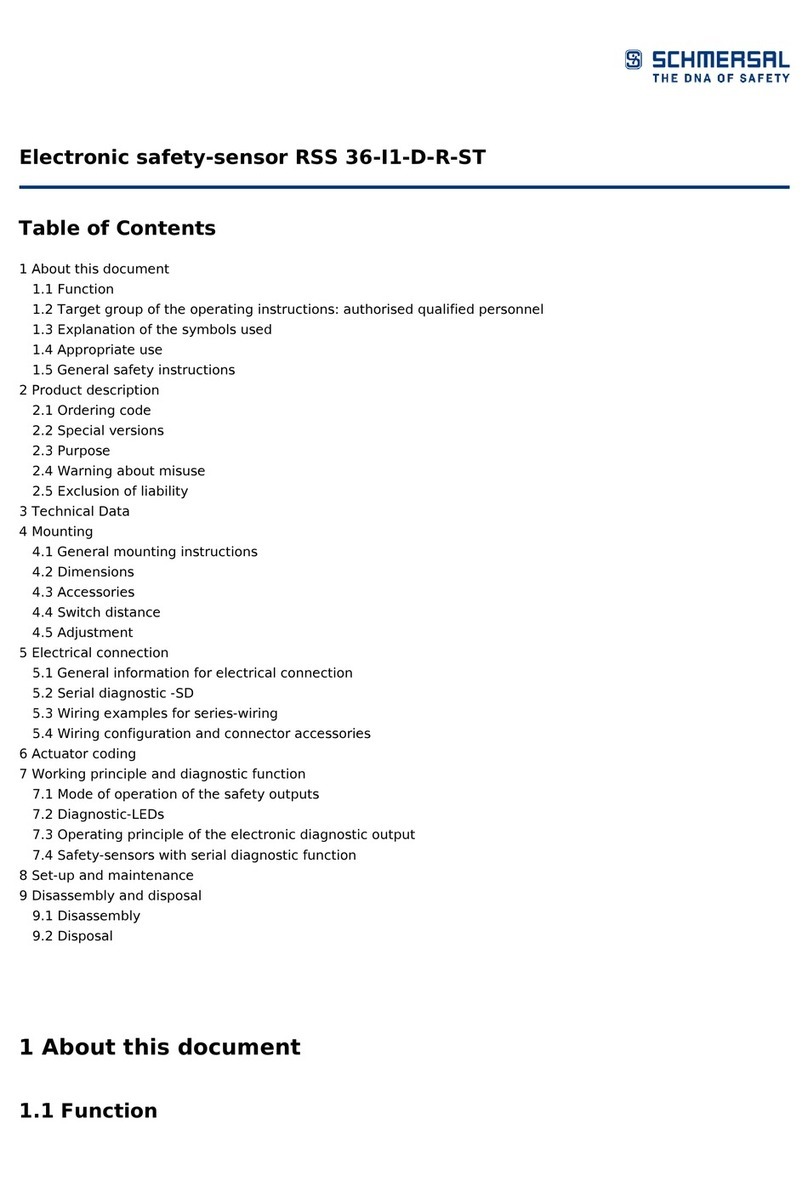
schmersal
schmersal RSS 36-I1-D-R-ST manual
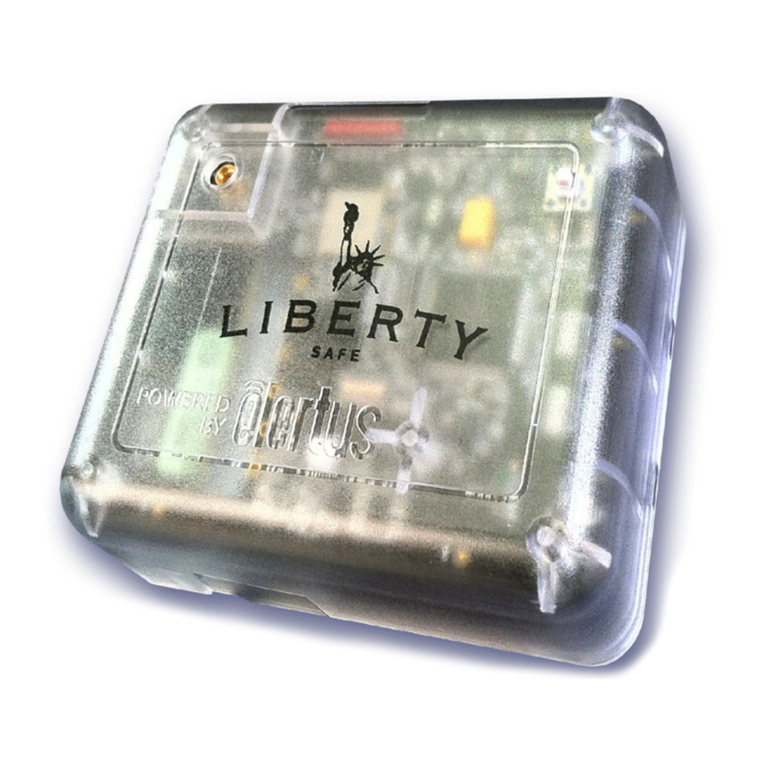
Safelert
Safelert Liberty user manual

Thermo Scientific
Thermo Scientific Thermo Scientific Dionex SRD-10 installation instructions
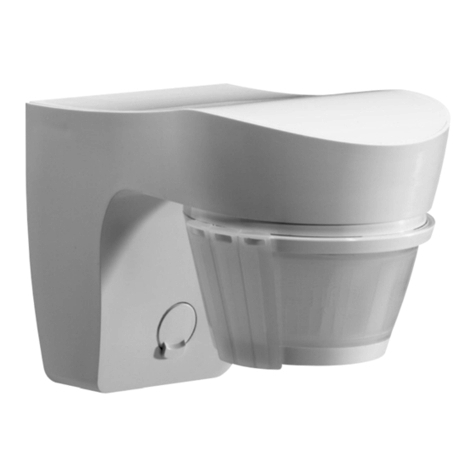
Flash
Flash Lumimat S140 quick start guide

